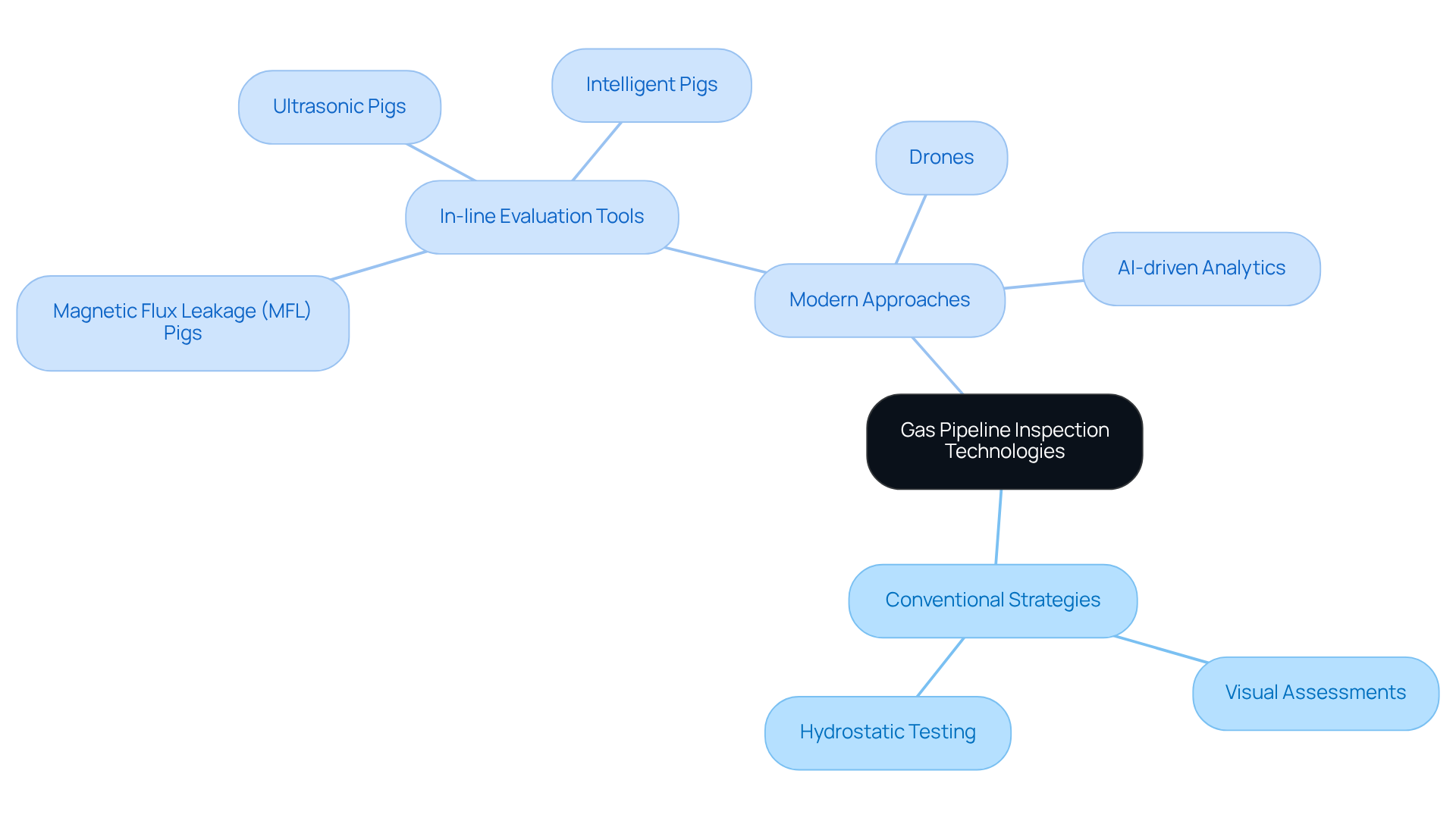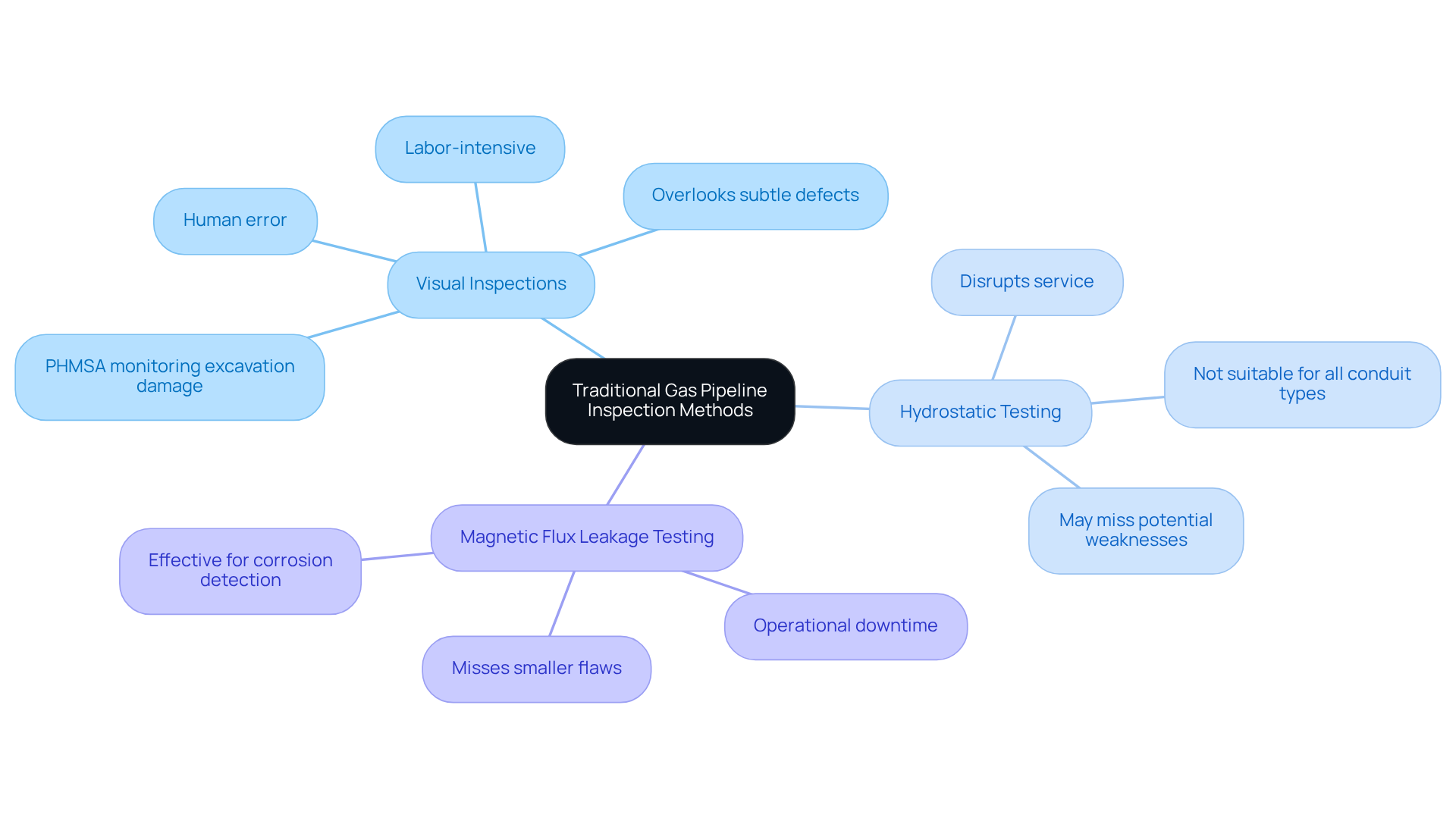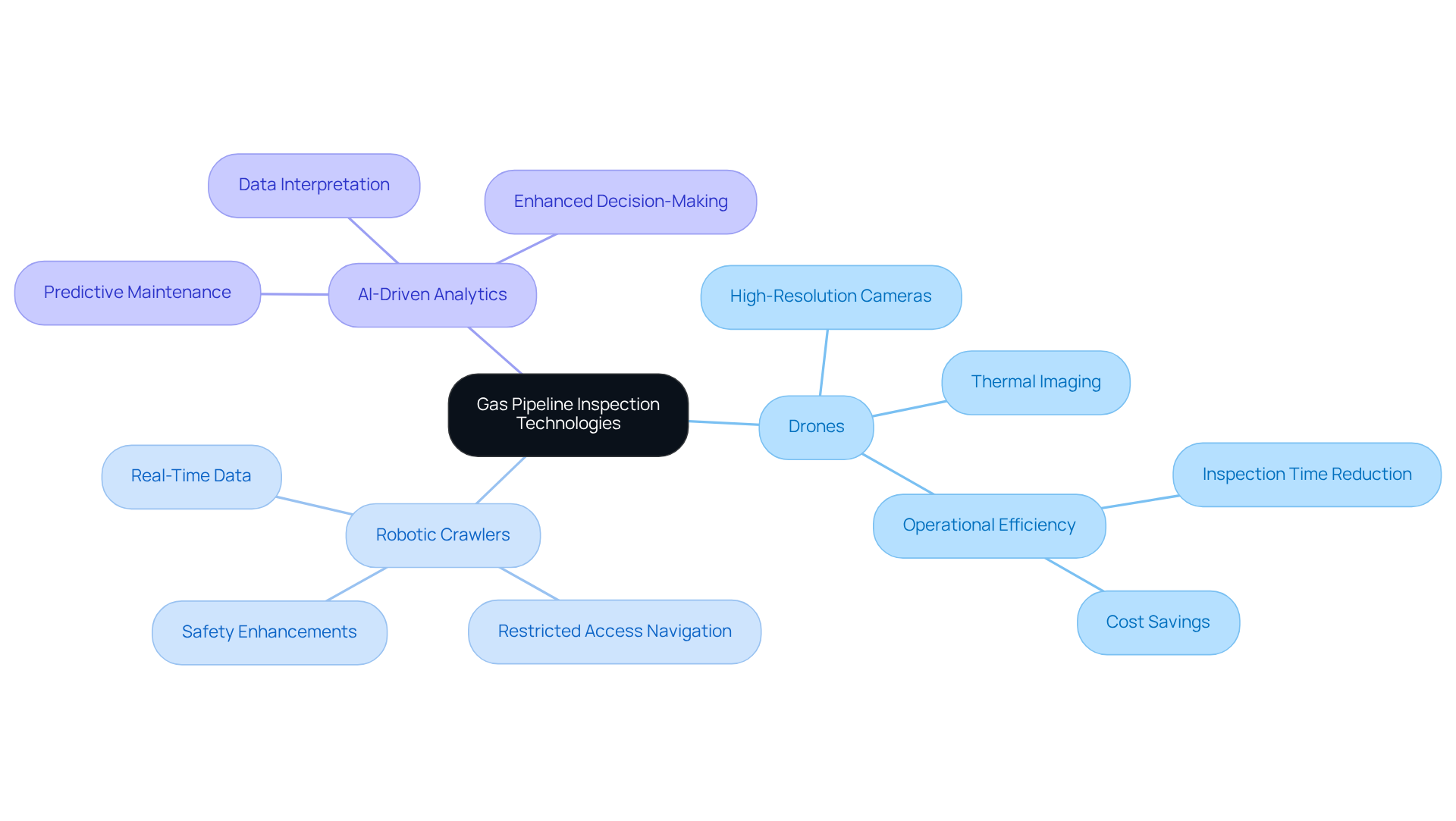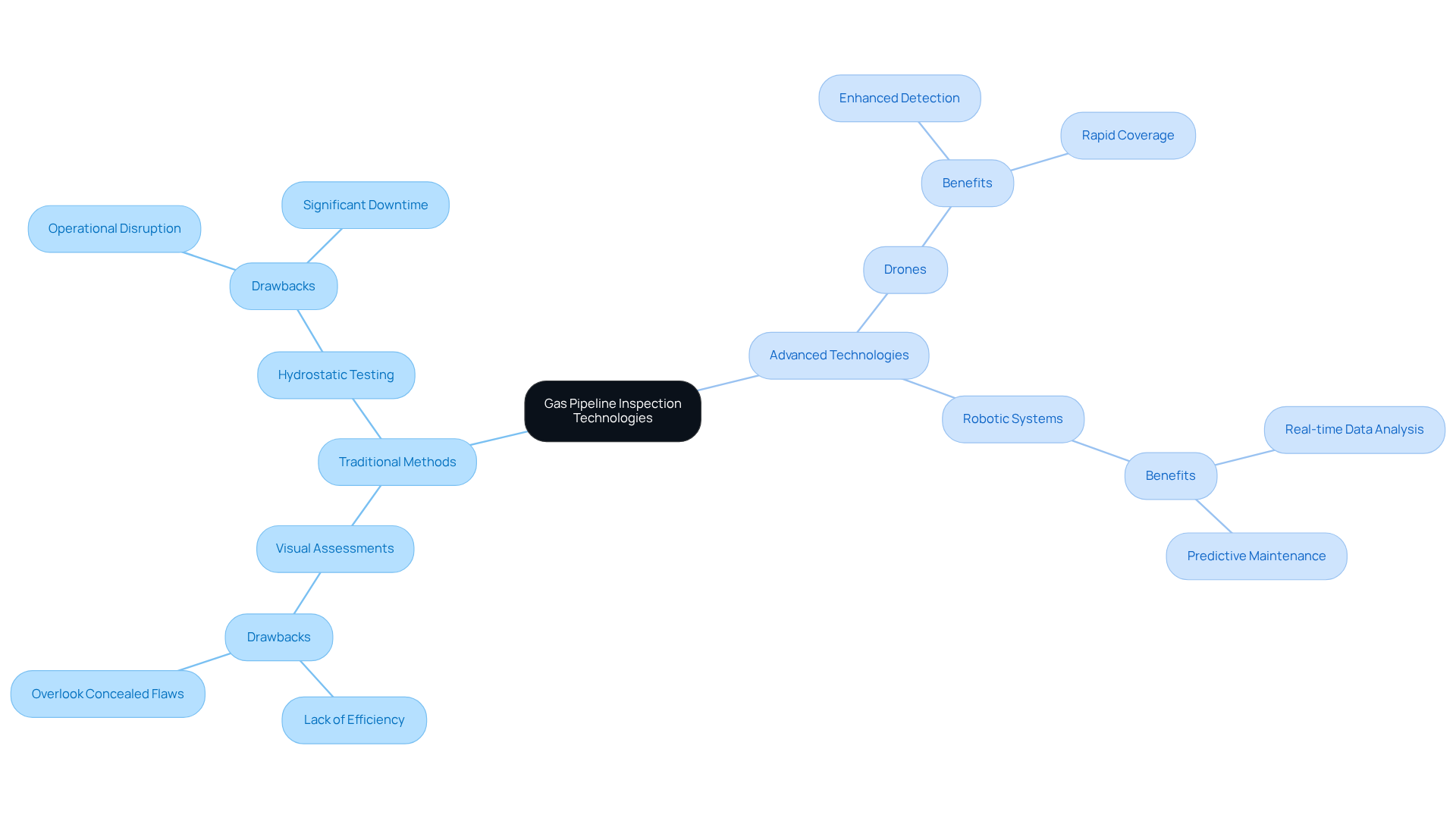Overview
The article presents a compelling comparison between traditional and advanced gas pipeline inspection technologies, underscoring the significant limitations of conventional methods. It highlights the transformative advantages of modern approaches, particularly those utilizing drones and AI-driven analytics. These advanced technologies markedly enhance efficiency, accuracy, and safety in pipeline evaluations, effectively addressing the operational risks and inefficiencies often associated with traditional inspection methods.
Introduction
Gas pipeline inspection stands as a crucial element in safeguarding the safety and integrity of energy infrastructure. The methods employed in this process can significantly influence operational efficiency and risk management. As industries encounter heightened regulatory scrutiny and the demand for improved safety protocols, the transition from traditional inspection techniques to advanced technologies brings forth both challenges and opportunities.
How can companies effectively navigate this transition? What are the implications for pipeline safety within the context of an evolving regulatory landscape? This article explores the comparative strengths and weaknesses of conventional and cutting-edge gas pipeline inspection methods, illuminating the future of pipeline safety and efficiency.
Overview of Gas Pipeline Inspection Technologies
Gas pipeline inspection technologies encompass a diverse array of techniques aimed at preserving the integrity and safety of pipeline systems. These techniques can be categorized into conventional strategies, such as visual assessments and hydrostatic testing, alongside modern approaches, including in-line evaluation (ILI) tools, drones, and AI-driven analytics. Traditional methods often rely on manual labor and periodic checks, which can result in inconsistencies and potential oversights. For instance, while visual assessments are beneficial, they may require systems to be temporarily taken offline, thereby limiting operational efficiency.
In contrast, advanced technologies harness automation and real-time data analysis to markedly enhance detection capabilities and operational efficiency. ILI tools, such as magnetic flux leakage (MFL) pigs, account for nearly 90% of all metal loss evaluations, providing high-resolution data concerning the integrity of conduits. These tools are adept at detecting various defects, including corrosion and pitting, with a depth sizing accuracy of ±1 mm for pits and ±0.5 mm for general corrosion, making them indispensable for ensuring pipeline safety. The InVista™ tool, capable of navigating intricate shapes, further exemplifies cutting-edge examination technologies by collecting extensive data in a single pass, thereby reducing operational costs.
The evolution of these technologies is a direct response to escalating safety regulations, particularly those set forth by the Pipeline and Hazardous Materials Safety Administration (PHMSA), which emphasize the need for robust examination protocols. The PHMSA has identified deficiencies in fundamental risk models employed within the industry, underscoring the importance of adopting enhanced evaluation techniques for compliance and risk management. Experts assert that integrating data from multiple sources and utilizing advanced analytics can significantly bolster risk assessment accuracy, addressing challenges such as inconsistent and incomplete data.
Ultimately, the importance of gas pipeline inspection technologies cannot be overstated, as they play a vital role in preventing operational failures and ensuring the safe transport of hazardous materials. The industry's shift towards more sophisticated evaluation techniques reflects a commitment to enhancing infrastructure integrity and safety in an increasingly regulated environment.

Traditional Gas Pipeline Inspection Methods: Characteristics and Limitations
Conventional gas conduit evaluation techniques present notable limitations that demand attention. Visual assessments, hydrostatic testing, and magnetic flux leakage (MFL) testing each possess unique features and restrictions that can compromise safety and efficiency.
-
Visual Inspections: On-site evaluations conducted by personnel can be labor-intensive and susceptible to human error. These inspections often overlook subtle defects, which can lead to significant safety risks. Notably, PHMSA monitors excavation damage occurrences as a primary cause of life-threatening events in conduit operations, underscoring the inadequacy of relying solely on visual evaluations.
-
Hydrostatic Testing: This method evaluates the integrity of the conduit by filling it with water and observing for leaks. While effective in specific situations, hydrostatic testing can disrupt service and is not suitable for all conduit types, particularly those deemed operationally critical. Furthermore, this process may fail to reveal all potential weaknesses, leaving systems vulnerable to undetected issues.
-
Magnetic Flux Leakage (MFL) Testing: MFL testing effectively identifies corrosion and metal loss but necessitates taking the pipeline offline, resulting in considerable operational downtime. This method may also miss smaller flaws that could escalate into significant problems if not addressed promptly.
In summary, these traditional evaluation methods often lack the efficiency and thoroughness required by today's regulatory environment, which gas pipeline inspection technologies can address, leading to heightened operational risks and potential safety hazards. As the sector evolves, there is an urgent need for more advanced gas pipeline inspection technologies that can provide comprehensive data and enhance safety within these systems.

Advanced Gas Pipeline Inspection Solutions: Innovations and Advantages
Gas pipeline inspection technologies utilize advanced solutions such as drones, robotic crawlers, and AI-driven analytics to enhance operational efficiency and safety. Drones, equipped with high-resolution cameras and thermal imaging capabilities, can swiftly survey extensive areas, detecting potential leaks and anomalies without interrupting service. For instance, the DJI Matrice 300 RTK dramatically reduces evaluation durations, enabling swift assessments that conventional techniques cannot rival; it can shorten assessment times for a single wind turbine from 3-6 hours to just 18 minutes.
Robotic crawlers are designed to navigate intricate pipeline systems, providing real-time data on structural integrity and ensuring that any issues are identified promptly. These crawlers excel in environments where human access is restricted, offering a safer option for evaluations. Furthermore, AI-powered analytics play a crucial role in interpreting the vast amounts of data collected, enabling predictive maintenance and facilitating quicker responses to potential problems.
The incorporation of gas pipeline inspection technologies not only enhances the precision and speed of evaluations but also lessens dependence on manual labor, thereby minimizing safety hazards and operational expenses. The market for conduit evaluation robots is projected to expand from $3 billion in 2023 to $13 billion by 2033, underscoring the growing demand for effective and reliable maintenance solutions in the oil and gas industry.
As Catherine Bernier, Content Manager, notes, "The robots' capability to carry out evaluations without human involvement in potentially dangerous conditions not only enhances safety but also significantly improves the efficiency and precision of the evaluation process.

Comparative Analysis: Traditional vs. Advanced Gas Pipeline Inspection Technologies
In comparing traditional and advanced gas pipeline inspection technologies, critical factors come to light. Conventional approaches, such as visual assessments and hydrostatic testing, often lack efficiency and precision. For example, visual evaluations can overlook concealed flaws, while hydrostatic testing may disrupt operations and lead to significant downtime, contributing to the estimated $260 billion manufacturers lose annually due to unanticipated interruptions.
Conversely, gas pipeline inspection technologies, including advanced drones and robotic systems, enhance detection capabilities and facilitate real-time data analysis, significantly minimizing operational downtime. These systems can rapidly cover extensive areas, and AI-driven analytics can predict maintenance needs, allowing for proactive interventions before problems escalate.
Industry specialists, like Troy, emphasize that integrating advanced gas pipeline inspection technologies not only improves accuracy but also enhances overall infrastructure integrity management. They highlight the importance of weighing the trade-offs between Direct Assessment and Inline Inspection for effective decision-making.
Ultimately, the choice between traditional and advanced methods depends on specific project requirements, regulatory compliance, and budget constraints, with advanced solutions typically providing a more effective and forward-thinking approach to ensuring pipeline safety and efficiency.

Conclusion
The examination of gas pipeline inspection technologies underscores a pivotal shift from traditional methods to advanced solutions that markedly enhance safety and operational efficiency. Conventional techniques, such as visual assessments and hydrostatic testing, have fulfilled their roles; however, they frequently lack precision and may introduce risks stemming from human error and operational downtime. In contrast, modern technologies utilize automation and real-time data analysis, establishing a more dependable framework for ensuring pipeline integrity.
Key insights from the article illuminate the shortcomings of traditional inspection methods, including their vulnerability to oversight and the potential for significant operational disruptions. Advanced techniques, such as drones and robotic crawlers, not only streamline the inspection process but also elevate the accuracy of defect detection. Moreover, the integration of AI-driven analytics promotes predictive maintenance, enabling timely interventions that can avert costly failures.
As the industry adapts to stringent safety regulations and the increasing demand for enhanced infrastructure integrity, the adoption of advanced gas pipeline inspection technologies is imperative. Stakeholders must prioritize these innovative solutions to safeguard operations, comply with regulatory standards, and ultimately ensure the safe transport of hazardous materials. Transitioning to advanced methods is not merely a trend; it represents a necessary evolution that emphasizes a commitment to safety and efficiency in the gas pipeline sector.
Frequently Asked Questions
What are gas pipeline inspection technologies?
Gas pipeline inspection technologies are techniques designed to preserve the integrity and safety of pipeline systems, including conventional methods like visual assessments and hydrostatic testing, as well as modern approaches such as in-line evaluation (ILI) tools, drones, and AI-driven analytics.
What are some conventional strategies used in gas pipeline inspection?
Conventional strategies include visual assessments and hydrostatic testing, which often rely on manual labor and periodic checks.
What are the limitations of traditional inspection methods?
Traditional methods can result in inconsistencies and potential oversights, and visual assessments may require systems to be taken offline, limiting operational efficiency.
How do advanced technologies improve gas pipeline inspection?
Advanced technologies utilize automation and real-time data analysis to enhance detection capabilities and operational efficiency, allowing for more accurate and timely inspections.
What are ILI tools and their significance in pipeline inspection?
ILI tools, such as magnetic flux leakage (MFL) pigs, are crucial for metal loss evaluations, providing high-resolution data on the integrity of pipelines and detecting defects like corrosion and pitting with high accuracy.
What is the accuracy of depth sizing for defects detected by ILI tools?
ILI tools have a depth sizing accuracy of ±1 mm for pits and ±0.5 mm for general corrosion.
What is the InVista™ tool and its advantages?
The InVista™ tool is an advanced inspection technology capable of navigating complex shapes and collecting extensive data in a single pass, which helps reduce operational costs.
Why is there an increasing emphasis on advanced inspection technologies?
The emphasis on advanced technologies is driven by escalating safety regulations from the Pipeline and Hazardous Materials Safety Administration (PHMSA), which highlight the need for robust examination protocols.
What challenges does the gas pipeline industry face regarding risk assessment?
The industry faces challenges such as deficiencies in fundamental risk models and the need for enhanced evaluation techniques to improve compliance and risk management.
What is the overall importance of gas pipeline inspection technologies?
These technologies are vital for preventing operational failures and ensuring the safe transport of hazardous materials, reflecting a commitment to enhancing infrastructure integrity and safety in a regulated environment.
List of Sources
- Overview of Gas Pipeline Inspection Technologies
- Technologies used in the inspection of natural gas pipelines (https://inspenet.com/en/articulo/inspection-of-natural-gas-pipelines)
- Safety & Inspection - Questions Answered by Pipeline Experts (https://dnv.com/news/2024/safety-inspection-ask-experts-questions-answered)
- Pipeline Inspection - an overview | ScienceDirect Topics (https://sciencedirect.com/topics/engineering/pipeline-inspection)
- Pipeline Inspection and Health Monitoring Technology-The Key to Integrity Management | Request PDF (https://researchgate.net/publication/362618189_Pipeline_Inspection_and_Health_Monitoring_Technology-The_Key_to_Integrity_Management)
- Evaluating Pipeline Inspection Technologies for Enhanced Corrosion Detection in Mining Water Transport Systems (https://mdpi.com/2076-3417/15/3/1316)
- Traditional Gas Pipeline Inspection Methods: Characteristics and Limitations
- Pipeline In-Line Inspection Method, Instrumentation and Data Management (https://mdpi.com/1424-8220/21/11/3862)
- Risk-Based Inspection (RBI) in Oil & Gas: A Complete Guide (https://excellenceintegrity.com/risk-based-inspection)
- Determine Pipeline Corrosion Growth Rates using SAC Assessments (https://inspectioneering.com/journal/2017-12-28/7206/determining-pipeline-corrosion-growth-rates)
- National Pipeline Performance Measures (https://phmsa.dot.gov/data-and-statistics/pipeline/national-pipeline-performance-measures)
- Evaluating Pipeline Inspection Technologies for Enhanced Corrosion Detection in Mining Water Transport Systems (https://mdpi.com/2076-3417/15/3/1316)
- Advanced Gas Pipeline Inspection Solutions: Innovations and Advantages
- Top Drones for Powerline & Substation Inspections (https://advexure.com/blogs/news/top-drones-for-powerline-substation-inspections)
- Commercial Drone Statistics 2024 By Region, Types, Application and Usage (https://enterpriseappstoday.com/stats/commercial-drone-statistics.html)
- Rethinking pipe inspection: Applying robots in harsh environments (https://howtorobot.com/expert-insight/rethinking-pipe-inspection)
- Energy & Utility Inspection Drones | Advexure (https://advexure.com/pages/energy-utility-drones)
- Advancements and Applications of Drone-Integrated Geographic Information System Technology—A Review (https://mdpi.com/2072-4292/15/20/5039)
- Comparative Analysis: Traditional vs. Advanced Gas Pipeline Inspection Technologies
- The Real Cost of Downtime in Manufacturing: Sector-by-Sector Breakdown and 2025 Forecasting (https://idsindata.co.uk/manufacturing-downtime-costs-and-forecasting)
- Safety & Inspection - Questions Answered by Pipeline Experts (https://dnv.com/news/2024/safety-inspection-ask-experts-questions-answered)
- 5 Stats on Predictive Modeling Impact in Manufacturing (https://numberanalytics.com/blog/predictive-modeling-manufacturing-stats)
- Cut Factory Downtime by 40% | LLumin Industrial Solutions (https://llumin.com/predictive-maintenance-in-2025-how-factories-slash-downtime-by-40)
- Predictive maintenance market: 5 highlights for 2024 and beyond (https://iot-analytics.com/predictive-maintenance-market)




